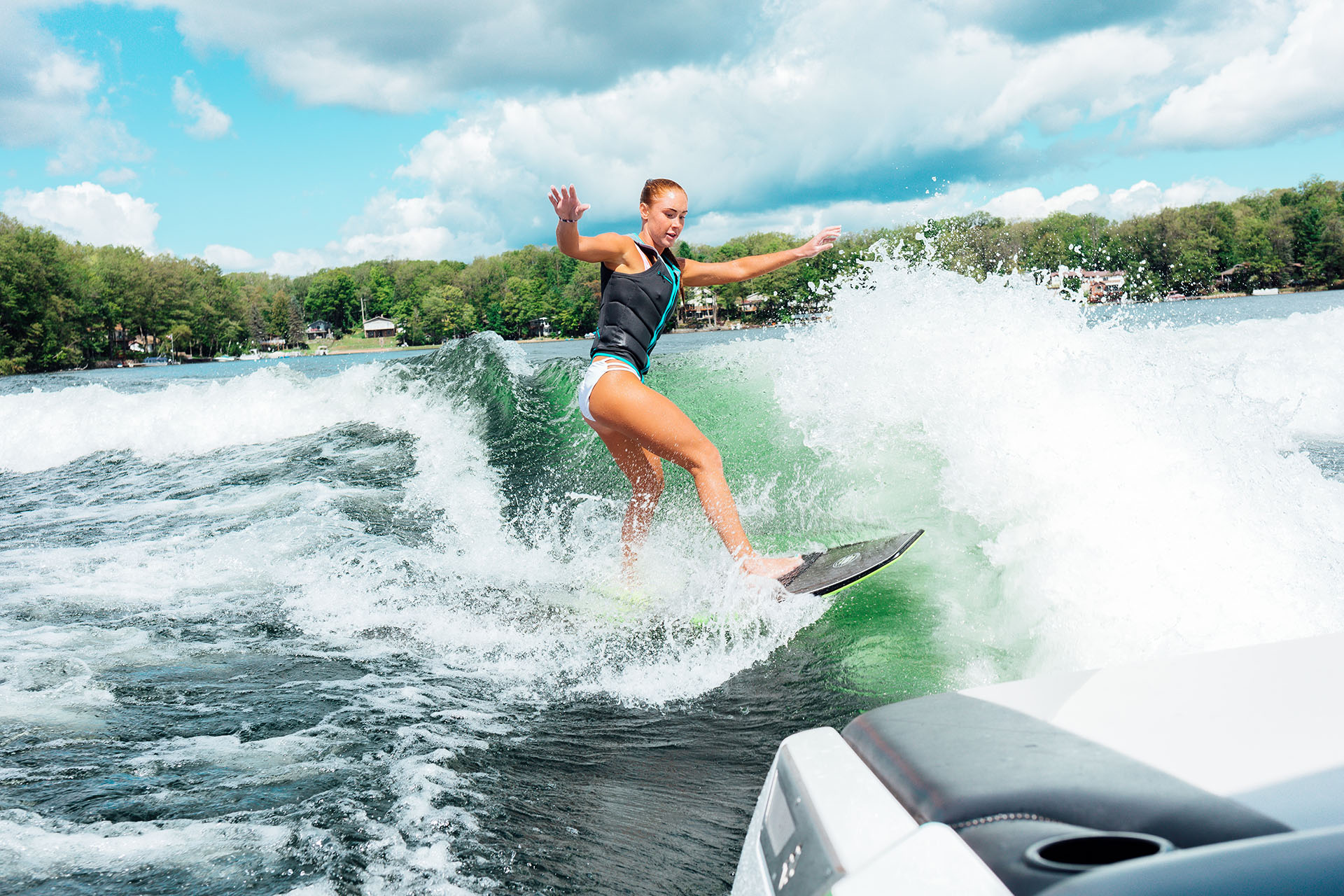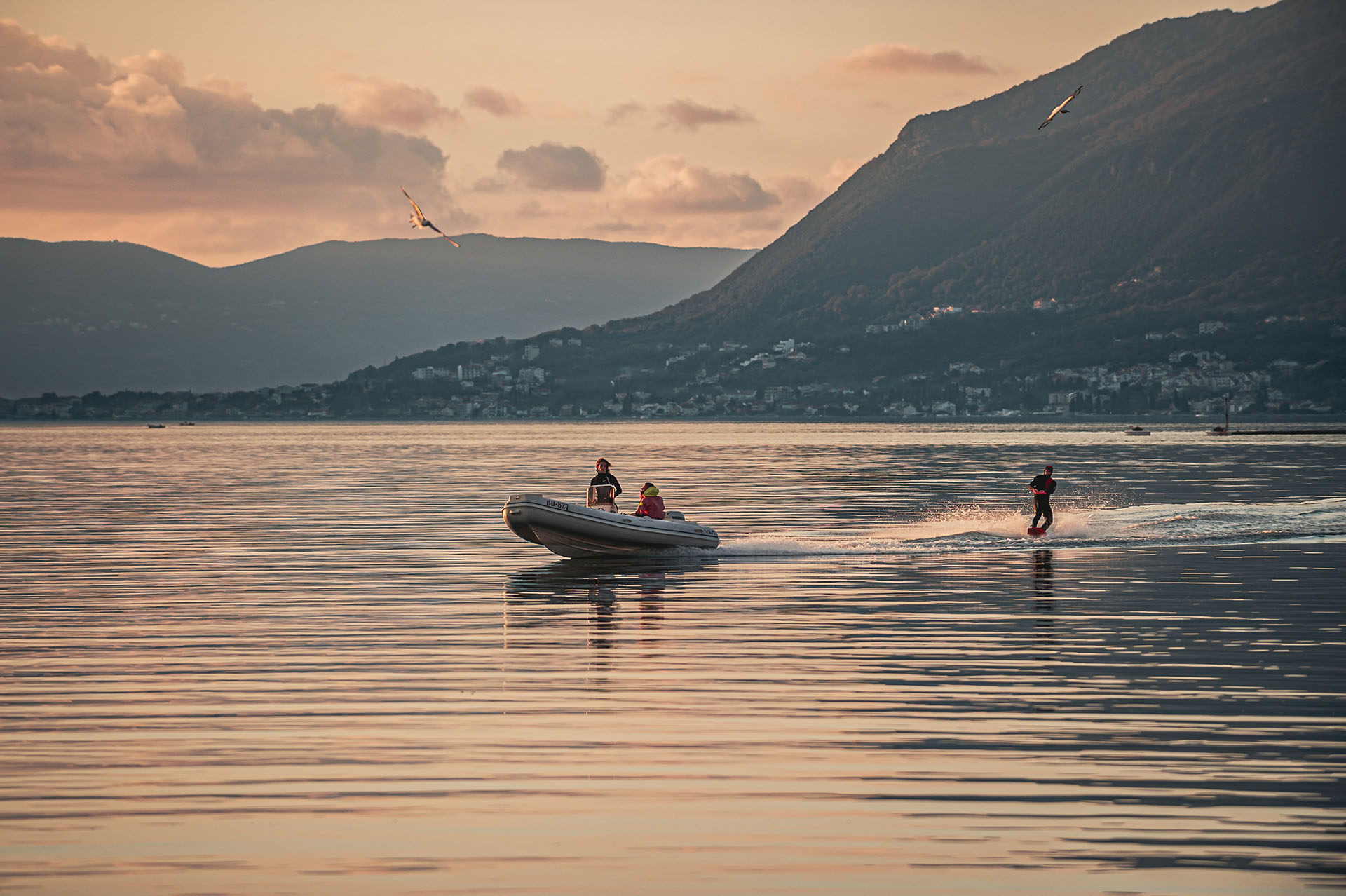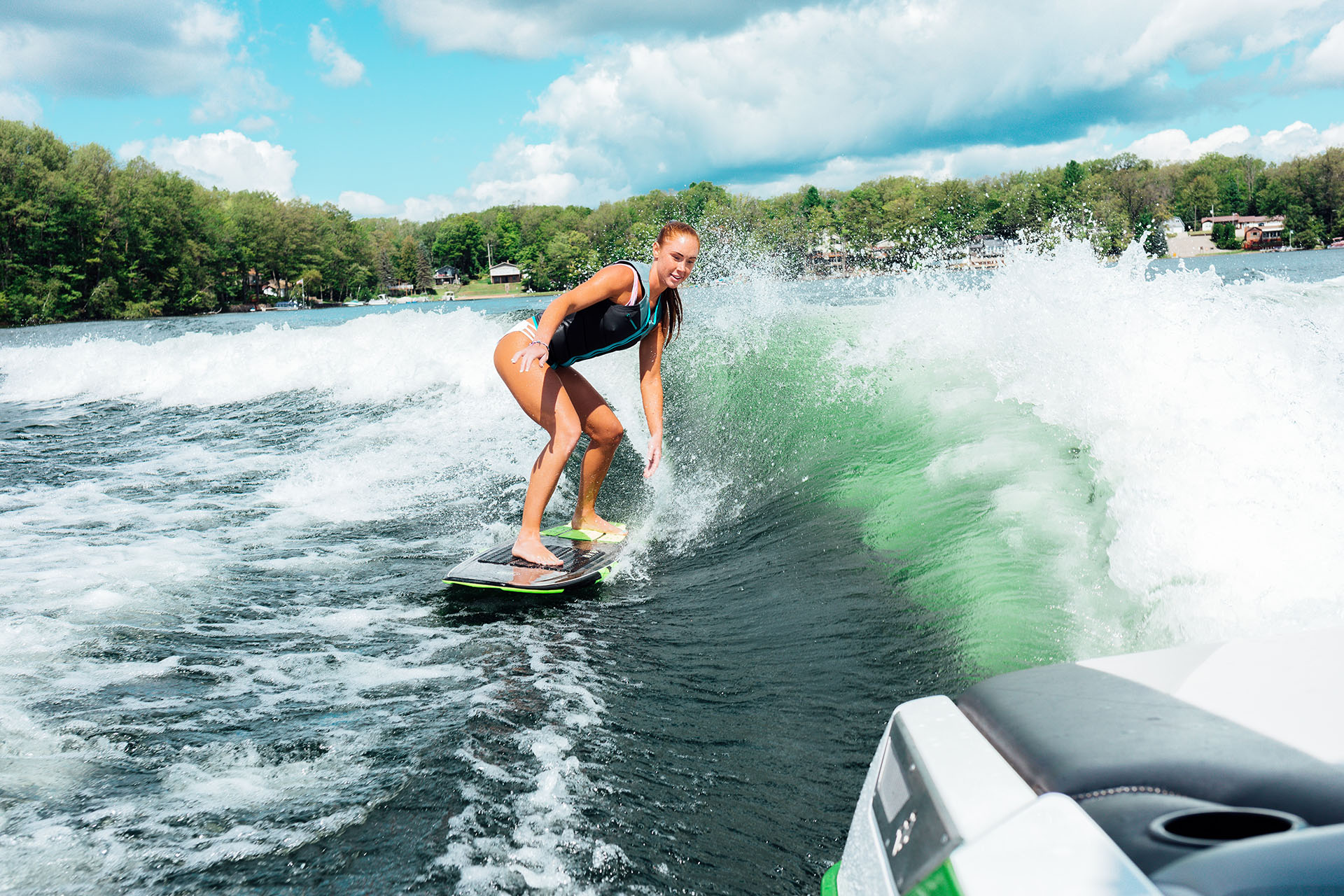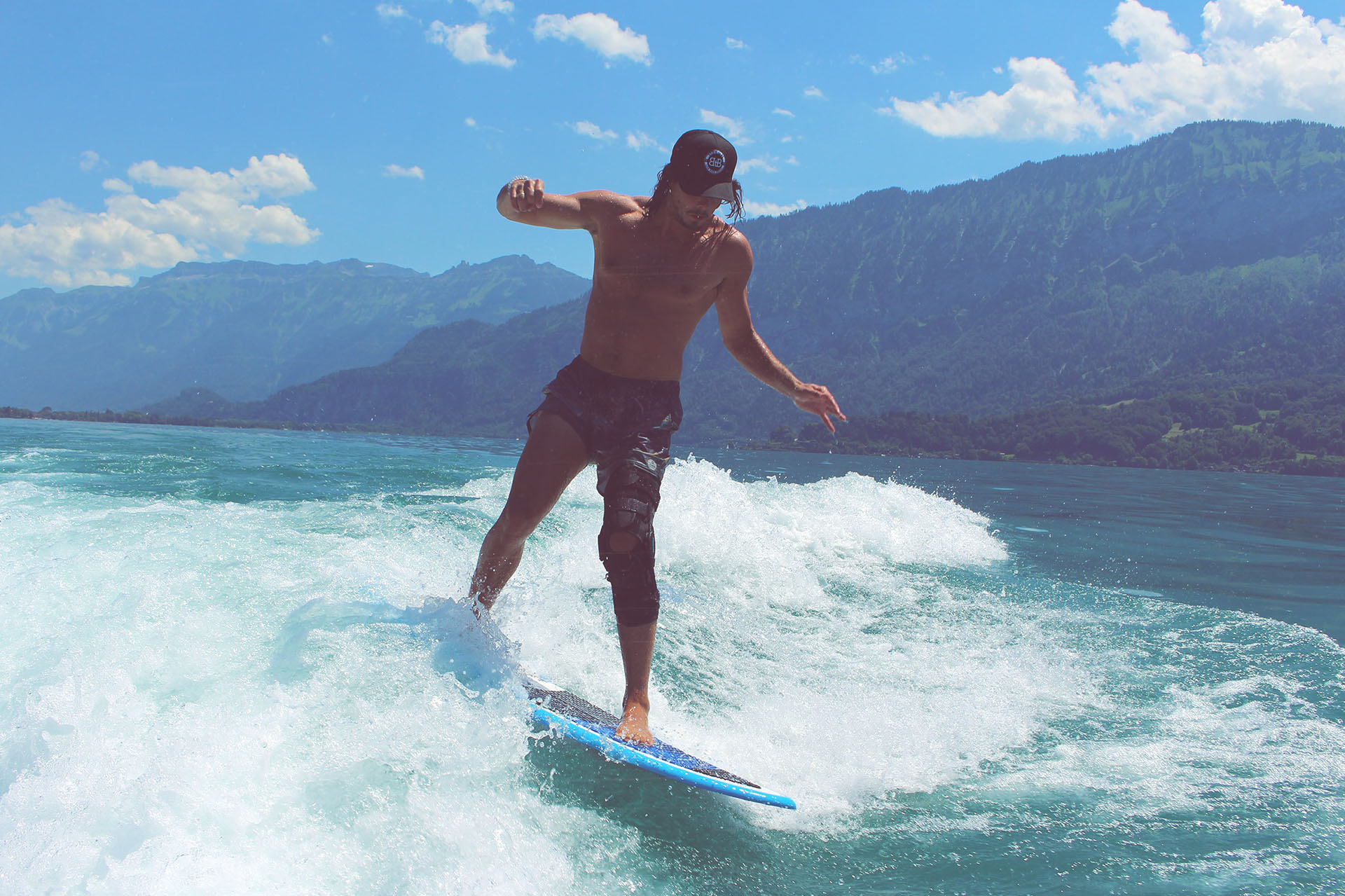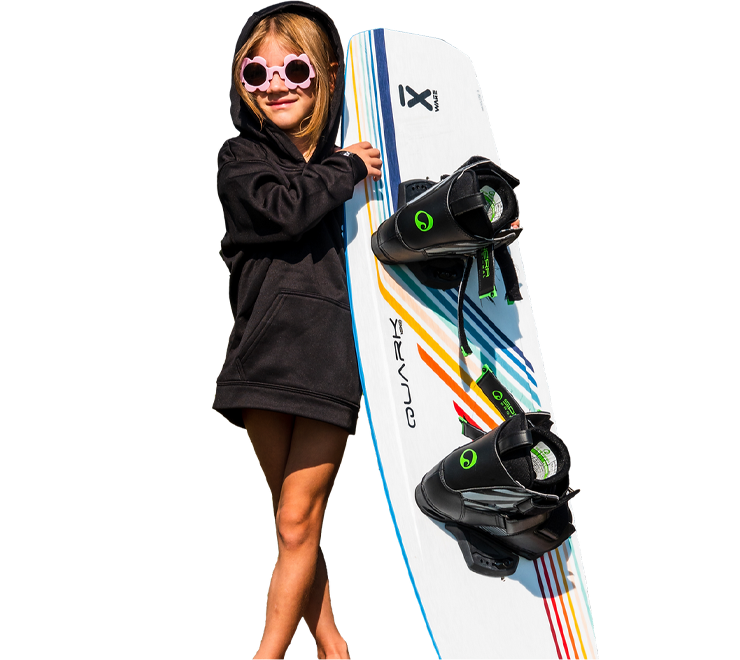Wakesurfing, an exhilarating water sport, has surged in popularity over recent years. But what is it exactly? Wakesurfing is a hybrid sport, blending elements of wakeboarding and surfing. It involves riding the wake of a boat without the assistance of a tow rope, once the rider is up and riding. This guide serves as a one-stop shop for all wakesurfing beginners out there.
Equipment Needed for Wakesurfing
Before diving head-first into the waves, there’s some essential equipment you’ll need.
Wakesurfing Board
If you’re taking the leap into the exhilarating world of wakesurfing, the board beneath your feet is more than just a piece of equipment—it becomes an extension of your body as you glide and dance on the water. Unlike traditional surfboards or wakeboards, wakesurfing boards have their own unique features and styles.
Firstly, wakesurfing boards are typically smaller and thicker. Their size ranges generally from 4 to 6 feet, while wakeboards and surfboards usually start at around 6 feet. This compact design allows for better maneuverability, helping you to smoothly carve through the water and pull off impressive tricks.
The thickness of wakesurfing boards, on the other hand, provides excellent buoyancy. It helps keep the board afloat and stable, making it easier for you to get up and maintain your balance on the water.
Now, let’s dive into the different types of wakesurfing boards. There are three primary styles to choose from, each designed to accommodate different skill levels and surfing styles:
- Skim-style Boards: Skim-style boards are relatively small and offer superb maneuverability. They are designed with a single fin and a symmetrical outline. This setup makes them perfect for spins, shuvits, and other skate-inspired tricks. If you’re an experienced rider looking to perform advanced tricks, or if you come from a skateboarding background, a skim-style board might be your best pick.
- Surf-style Boards: Surf-style boards are the closest to traditional ocean surfboards in design. They are more significant and more buoyant than skim-style boards, with more substantial tails and usually three fins. These characteristics provide increased stability and control, making surf-style boards excellent for big carves, powerful turns, and airs. They are a great option for beginners or riders who prefer a more laid-back and traditional surfing experience.
- Hybrid Boards: As you might guess from the name, hybrid boards merge the best qualities of skim and surf-style boards. They are versatile, offering stability for easy cruising and enough agility for tricks. Hybrid boards are suitable for riders who want to experience a variety of wakesurfing styles without needing multiple boards.
Remember, the perfect wakesurfing board for you ultimately depends on your personal preference, skill level, and riding style. No matter what type of rider you are, there’s a board out there waiting to carry you across the wake. As you spend more time on the water, you’ll get to know more about what works for you and what you enjoy most in your ride. Happy wakesurfing!
Wakesurfing Rope
When you’re preparing to ride the wave, the wakesurfing rope is your trusty sidekick. It’s more than just a line between you and the boat; it’s your connection to the wake, a guide helping you find the perfect spot to surf. But not all ropes are created equal. Let’s explore what makes a wakesurfing rope special and why it’s a crucial piece of your wakesurfing kit.
Unlike the ropes used for other watersports like water skiing or wakeboarding, wakesurfing ropes are designed with specific features that cater to the unique demands of the sport.
Firstly, wakesurfing ropes are generally thicker. Why so? Because a thicker rope is easier to grip, giving your hands a break and preventing rope burn. This feature is particularly important since you’ll be starting in the water, requiring a good pull to get up onto your board.
Another characteristic that distinguishes wakesurfing ropes is the addition of knots or foam grips. Have you ever tried climbing a rope without any knots? Quite a task, right? Similarly, in wakesurfing, these knots or foam sections provide places to grip, allowing you to pull yourself incrementally closer to the boat, and into the “sweet spot” of the wake. This is where the boat’s wake is cleanest and most surfable – it’s where you want to be!
Also, wakesurfing ropes are generally shorter than waterski or wakeboard ropes. The length usually ranges from 15 to 25 feet, compared to the 65 to 75 feet common in wakeboarding ropes. The shorter length keeps you close to the boat, precisely where the wake is just right for surfing.
Finally, many wakesurfing ropes feature a bright color or design. This isn’t just for style points (though they certainly don’t hurt!). A brightly colored rope is more visible in the water, improving safety by helping the driver and other boaters see it more easily.
Wetsuit
Even though the idea of diving into an ocean or lake sounds incredibly refreshing, the water’s temperature might not always agree with you. That’s where the mighty wetsuit steps in. A wetsuit serves as your personal, flexible armor, designed to keep you warm, safe, and comfortable during your wakesurfing adventure.
A wetsuit is not just any ordinary piece of clothing. It’s an engineered garment made primarily from neoprene, a type of synthetic rubber that has excellent insulating properties. The principle behind its operation is fascinating. A wetsuit allows a thin layer of water to seep in between your body and the suit. Your body heat warms up this water, creating a warm and insulating layer that keeps the chill at bay, even in colder waters.
Now, while the fundamental purpose of a wetsuit is to keep you warm, its benefits don’t stop there.
- UV Protection: A day of wakesurfing means a day in the sun, and while the golden rays make for a great day out, they can also pose a risk to your skin. Wetsuits offer excellent protection from harmful UV rays, reducing the risk of sunburn and long-term skin damage.
- Abrasion Protection: Lakes and oceans aren’t always just pure water. There can be rocks, corals, or other underwater objects that may potentially harm you. Wearing a wetsuit provides an extra layer of protection against scrapes and cuts.
- Buoyancy: The neoprene material in wetsuits is filled with tiny air bubbles, making it naturally buoyant. This feature can give you a little boost in keeping afloat, especially when you’re waiting for the boat to circle back.
When choosing a wetsuit, it’s important to consider the temperature of the water you’ll be surfing in. Wetsuits come in various thicknesses, measured in millimeters (mm). A thicker wetsuit (e.g., 5/4mm) is designed for colder water, while a thinner one (e.g., 2/2mm) is suitable for warmer conditions.
Additionally, wetsuits come in different styles, such as full suits, spring suits, and long johns, each offering a different level of coverage suitable for various weather and water conditions.
Wake Boat
If wakesurfing were a rock concert, then the wake boat would undoubtedly be the headline act. These special boats are the magic behind your wakesurfing fun, creating the powerful wake that serves as your personal, endless wave. However, these aren’t your everyday speedboats; let’s pull back the curtain and take a closer look at the star of the show.
Wake boats, specifically designed for wakesurfing, are the architects of that perfect, surfable wake you crave. This marvel is accomplished through a blend of clever engineering and a dash of physics.
First and foremost, the boats are equipped with an inboard propulsion system. Unlike traditional outboard or stern drive boats, inboard boats have the propeller tucked underneath the boat. This design increases safety for wakesurfers who are surfing close to the boat, preventing any contact with the propeller.
Additionally, the boats have specialized hull designs that help shape the wake. Deep-V hulls displace more water, creating a larger wake. Some boats even come with adjustable hulls that allow you to tailor the wake’s size and shape, offering a customizable ride.
One of the most vital components of a wake boat is its ballast system. Ballast systems add weight to the boat, which in turn increases the amount of water displaced, resulting in a bigger wake. These systems can be filled with water and often are strategically placed throughout the boat to allow for adjustments to the wake’s shape and size. Some high-end boats even have automated ballast systems that fill or drain at the touch of a button.
In terms of speed, wake boats tend to operate at a leisurely pace compared to other water sports. The typical speed for wakesurfing is usually around 9-11 mph. This slower speed creates the perfect energy and shape for the wave, allowing wakesurfers to ride without being directly tethered to the boat.
Lastly, modern wake boats often come equipped with advanced technology for convenience and performance. This can include touchscreen controls, GPS-based speed control, and even wave-shaping systems that allow you to adjust the wake’s size, shape, and length.
Basic Techniques of Wakesurfing
Now that we’ve got the gear covered, let’s get you started on the water!
Getting Started on the Water
Eager to carve your first wake? We get it! However, it’s important to remember that the initial leap into wakesurfing requires a dash of patience and a sprinkle of technique. The good news is, the process of getting up on a wakesurf board is somewhat akin to getting up on a wakeboard or waterskis. The secret sauce? Let the boat do the heavy lifting!
- Prepare to Enter the Water: Before you jump in, make sure you have your life jacket fastened securely, your board ready, and your wakesurfing rope in hand. Once you’re all set, step off the back of the boat into the water, holding your board on one side and the rope on the other.
- Position Yourself: With your feet resting on the board, adjust yourself so that your heels align with the back edge of the board. The board should be perpendicular to the rope. Bend your knees and pull them to your chest. Keep the rope on your hip to ensure the pull comes from your core, not your arms.
- Lean Back and Relax: As the boat begins to pull you, lean back and let the boat do the work. It can be tempting to try to stand up immediately, but resist! Your goal during the initial pull is to maintain your tucked position, allowing the board to plane on top of the water.
- Stand Up Gradually: Once your board is planing, you can start to stand up. Push down on your heels and gradually extend your legs. Remember to let the boat continue to do the work. The speed of the boat and the tension in the rope will help pull you up to a standing position.
- Stance and Balance: Once up, your stance should be sideways, similar to a skateboard or snowboard stance. Your weight should be evenly distributed, with a slight lean towards your front foot. Keep your eyes forward, looking towards the boat, and let your body follow.
- Ride the Wave: After you’ve successfully stood up, your next goal is to find the “sweet spot” in the wake where you can surf it without the help of the rope. As you feel comfortable, you can start to let go of the rope or toss it back to the boat and truly start to surf the wave!
Catching the Wake
Congratulations on standing up on your wakesurf board! But, the fun’s just starting. Now comes the true essence of wakesurfing—catching the boat’s wake and riding it like a boss. Think of it as catching your first-ever green wave in traditional surfing, only this wave doesn’t dissipate. Sounds thrilling, doesn’t it?
Catching the wake and finding the “sweet spot” where you can surf freely without the rope might seem daunting at first. However, with a bit of practice and a few tips, you’ll be surfing the wake in no time!
- Understanding the Wake: Before you attempt to catch the wake, it’s important to understand what you’re dealing with. The wake created by the boat has two sides: the port side (left) and the starboard side (right). Depending on the boat’s design and weight distribution, one side may have a cleaner, larger wake than the other. The rider’s stance (regular or goofy) will also influence which side of the wake they choose to ride.
- Positioning: When you’re comfortably up and riding, you’ll find yourself in the “wash” of the wake, a frothy, turbulent area. Your aim is to move out of this wash and onto the clean, smooth part of the wave.
- Weight Distribution: Adjusting your weight plays a pivotal role in moving around the wave. To move closer to the boat, put more weight on your front foot. Conversely, to drift back out, shift your weight to your back foot. Be sure to make these weight transfers gradual to maintain balance.
- Using the Rope: Initially, the wakesurf rope can help you find the sweet spot. As you ride, you can pull yourself gently towards the boat using the rope, helping you move into the clean area of the wake.
- Finding the Sweet Spot: The “sweet spot” is the area of the wake where the wave’s energy is just right to keep you moving at the same speed as the boat without the assistance of the rope. This is typically found just behind the boat, on the downward slope of the wake. When you hit this spot, you’ll feel the wave pushing you along.
- Letting Go of the Rope: Once you’re comfortably surfing the sweet spot of the wake, you can let go of the rope! Some people prefer to drop it, while others like to fling it gently towards the boat, out of the way.
Balance and Control
Wakesurfing is an exquisite dance between balance and control. Just as a dancer moves across a stage, a wakesurfer glides across the water, their movements dictated by the rhythm of the wake. It’s a performance that involves a fine balance, precise control, and a deep connection with the water beneath you. Here, we’ll delve into the art of maintaining balance and control while wakesurfing.
- Understanding Weight Distribution: A key aspect of balance in wakesurfing lies in the distribution of your weight on the board. This is achieved by shifting your weight back and forth between your front and back foot. Generally, a balanced stance will have around 60% of your weight on your front foot and 40% on your back foot. However, the actual distribution can change as you navigate the wake.
- Shifting Your Weight: Shifting your weight towards the front of the board helps you accelerate and move closer to the boat. Conversely, leaning towards the back of the board causes you to decelerate and move away from the boat. Mastering this shift of weight is fundamental to controlling your speed and position on the wake.
- Bend Your Knees: Keeping a slight bend in your knees can greatly enhance your balance on the board. Think of your knees as shock absorbers, absorbing the movements of the wave and the board. This also lowers your center of gravity, making it easier to maintain your balance.
- Body Alignment: Your body alignment is also critical. Your chest should be open, facing towards the boat, while your hips and feet are in line with the board. Keep your head up and eyes looking forward. This stance promotes stability and makes it easier to steer the board.
- Using Your Arms: Your arms can also assist in maintaining balance. When holding onto the rope, your arms should be relaxed and slightly bent. Once you let go of the rope, you can use your arms for balance, extending them outward and shifting them as needed.
- Practice Makes Perfect: Just like any other water sport, practice is crucial. The more time you spend on the water, the better your body will become at intuitively maintaining balance and control. Each wave is a new chance to learn and grow as a wakesurfer.
Advanced Wakesurfing Techniques
As you progress, you can start to explore some more advanced techniques.
Cutting and Carving
As you grow more comfortable with wakesurfing basics, the urge to move beyond simply riding the wave grows stronger. It’s time to enter the world of cutting and carving—the next level in your wakesurfing journey. These maneuvers involve a more dynamic use of your weight and the edges of your board to weave an exciting path across the wave.
- Understanding Cutting and Carving: Cutting and carving involve making turns or ‘cuts’ across the wave, allowing you to traverse the wake from one side to the other. While similar, carving typically refers to more aggressive, sharper turns that are similar to carving on a snowboard or skateboard.
- The Role of Weight Shift: Similar to maintaining balance, weight shifting is vital for cutting and carving. Leaning into your front foot will drive you down towards the trough of the wake, while leaning back onto your rear foot will push you up the face of the wake. The key is to make these weight shifts smoothly and progressively.
- Using Your Edges: As you shift your weight to initiate a cut, you’ll also need to engage the edge of your board. If you’re cutting up the wave, lean back and dig the edge of the board into the wave. If you’re cutting down, shift your weight forward and use the edge to carve your path.
- Arm Position: While cutting and carving, your arm position becomes even more crucial. As you turn, lead with your front arm, extending it in the direction you want to go. This not only helps to guide your movement but also aids in maintaining your balance during the turn.
- Cutting Techniques: Start with gentle cuts across the wake, gradually shifting your weight and using your edges to change direction. As you get comfortable, you can start to make more aggressive cuts, leaning further into your turns and using your knees as shock absorbers during the transition.
- Advanced Carving: As your skills progress, you might start to explore more advanced carving techniques. These might involve bigger, more aggressive turns, slashing the lip of the wake, or even launching yourself off the wake for aerial maneuvers.
Performing Jumps
After mastering the art of carving, you might find yourself craving an additional thrill. Why not aim for the sky and try jumping the wake? Launching yourself off the wake is a truly exhilarating experience that takes your wakesurfing journey to new heights. However, pulling off successful jumps requires not just courage but also impeccable timing, strength, and a solid understanding of board control.
- Understanding Wake Jumps: A wake jump involves using the energy and shape of the wake to launch yourself and the board into the air. It’s a thrilling maneuver that gives you a taste of the airborne side of wakesurfing.
- Timing is Everything: One of the critical aspects of performing jumps is impeccable timing. You need to approach the wake’s peak just as it’s about to break, harnessing its energy to propel you upwards. This takes practice and a keen understanding of the wake’s behavior.
- The Approach: Start by carving out away from the wake and then turn to carve back in, building up speed as you approach the wake. This movement should be smooth and controlled.
- The Launch: As you reach the crest of the wake, it’s time to jump. Crouch down slightly, and as you rise, spring up off your back foot, extending your legs and lifting your knees towards your chest. This upward motion, combined with the energy of the wave, will help propel you into the air.
- Board Control: While in the air, your board control is crucial. Keep your feet firmly on the board, maintaining contact at all times. Keeping your center of gravity low and your knees bent will aid in maintaining control.
- The Landing: Landing a jump can be as challenging as the jump itself. Aim to land with your weight evenly distributed on both feet and your knees slightly bent to absorb the impact. Remember, it’s important to stay relaxed and flexible during the landing to prevent any potential injuries.
- Practice Safely: As with all new maneuvers, make sure you are confident with your basic wakesurfing skills before attempting jumps. Always wear a suitable life jacket, and remember, the aim is to enjoy the process. Start with small jumps and gradually work your way up as your confidence and skills improve.
Wake jumping is undoubtedly a spectacular sight and a thrilling experience. It encapsulates the spirit of wakesurfing, marrying the serenity of riding the wave with the adrenaline rush of flying high. So buckle up, get out there, and give it a go. Who knows, you might just catch some serious air!
Mastering Wakesurfing Tricks
Every artist needs to learn a few tricks of the trade, and in wakesurfing, it’s no different. The world of wakesurfing tricks is vast and varied, with a plethora of maneuvers to learn, ranging from spectacular 360s to breathtaking alley-oops and everything in between. Beginning with simpler tricks and gradually raising the bar as your confidence and skill set grows, can turn your wakesurfing journey into an awe-inspiring display of acrobatics.
- Understanding Wakesurfing Tricks: Wakesurfing tricks are special maneuvers that you perform while riding the wake. These tricks add flair and excitement to your wakesurfing, transforming a simple ride into an awe-inspiring performance.
- Starting Simple: Begin your journey into wakesurfing tricks with simpler maneuvers. One of the first tricks you might try is the ‘Body Varial,’ where you rotate your body 180 degrees on the board while keeping the board still. This trick lays the foundation for more complex spins in the future.
- The 360 Spin: Once you’re comfortable with simpler tricks, you might want to attempt a ‘360 spin.’ This trick involves spinning your board 360 degrees while maintaining balance and staying within the wake. It requires a good understanding of weight transfer and board control.
- The Alley-oop: For those seeking a bit more thrill, the ‘alley-oop’ might be the next step. In this trick, you launch off the wake into an air 180, landing back on the wave in the same direction. It’s a complex trick that requires precision, timing, and a good deal of courage.
- Progressing Gradually: The key to mastering wakesurfing tricks is to progress gradually. Try not to rush the process. Instead, focus on mastering each trick before moving on to the next. Remember, every professional wakesurfer started with the basics.
- Safety First: Always keep safety in mind when trying new tricks. Wakesurfing can be physically demanding and requires a good deal of strength and agility. Ensure you’re physically prepared and always wear the appropriate safety gear.
- Practice, Practice, Practice: There’s no shortcut to mastering wakesurfing tricks. It requires practice, patience, and a whole lot of determination. But don’t let the challenge deter you; remember, every wipeout is just a step on the path to mastery.
Dare to take your wakesurfing to the next level and dive into the world of tricks. Remember, wakesurfing is not just about the destination; it’s about the journey. So take a deep breath, hop on your board, and let the water guide you. Who knows what spectacular tricks you’ll be pulling off in no time?
Safety Considerations in Wakesurfing
No doubt, wakesurfing is a thrilling, adrenaline-pumping sport that draws enthusiasts from all walks of life. However, like any water sport, it comes with its inherent risks. Keeping safety considerations at the forefront is essential to ensure that the excitement and joy of wakesurfing are not overshadowed by avoidable accidents or injuries.
- Personal Floatation Device (PFD): The first and foremost safety rule in wakesurfing, as with any water sport, is to always wear a personal floatation device or life jacket. Ensure it’s U.S. Coast Guard approved, fits you correctly, and is suitable for the conditions in which you’ll be surfing.
- Proper Equipment: Using the right equipment not only enhances your performance but also ensures your safety. Ensure that your wakesurfing board is in good condition and your wakesurfing rope is specifically designed for wakesurfing with foam grips or knots.
- Understanding Your Boat: You should know your boat well, especially if you’re the one driving. Understanding the speed controls, how to create the perfect wake, and most importantly, ensuring your boat is equipped with a wake plate or surf system are vital for safety.
- Spotter: Always have a spotter on the boat while you’re wakesurfing. A spotter’s job is to keep an eye on the surfer at all times and to alert the driver if the surfer falls.
- Swimming Skills: A strong swimmer always has an advantage in any water sport. If you’re not a strong swimmer, it’s recommended that you improve your swimming skills before taking up wakesurfing.
- Weather and Water Conditions: Always check the weather forecast and water conditions before heading out for wakesurfing. Avoid rough water and stormy weather.
- Safety Distance: Maintain a safe distance from the boat at all times. As a rule of thumb, you should be at least twice the length of the rope away from the boat when starting.
- Alcohol and Drugs: Never wake surf while under the influence of alcohol or drugs. They can impair your balance, coordination, and judgment, significantly increasing the risk of accidents.
- Respect for Other Water Users: Be aware of and respectful towards other water users. This includes maintaining a safe distance from other boats, surfers, swimmers, and respecting local rules and regulations.
- Learning from Professionals: Consider taking a few lessons from a professional wakesurfing instructor when starting out. They can provide valuable guidance on technique and safety.
Understanding Boat Safety
A critical component of wakesurfing safety lies within the boat itself. Navigating the waters with a vessel involves adhering to specific rules and regulations for everyone’s wellbeing. A designated boat driver, fully aware of the protocols, and a diligent spotter play crucial roles in this process.
- Designated Boat Driver: The person at the helm of the boat has a significant responsibility. They should be familiar with the boat’s operation, understand water safety regulations, and be capable of managing the vessel under different conditions. This responsibility includes knowing how to set and control the boat’s speed appropriately for wakesurfing (generally around 9-11 mph) and creating the optimal wake for the surfer.
- The Role of the Spotter: While the driver is focused on the path ahead, it’s the spotter’s job to keep their eyes glued on the surfer. They should maintain constant visual contact, ready to alert the driver at the first sign of any issues – whether the surfer falls, loses the rope, or signals for help. The spotter’s role is vital to ensuring immediate action in case of any mishap, minimizing the risk of injury.
- Boat Safety Regulations: Apart from being adept at boat handling, the driver should be fully conversant with local boating regulations. These can include rules about speed limits, right of way, and restricted areas. Compliance with these regulations ensures the safety of everyone on board and other water users.
- Emergency Preparedness: The boat should be equipped with necessary safety equipment, including a first aid kit, extra floatation devices, a fire extinguisher, and a means of communication for emergencies. Both the driver and the spotter should know how to use these tools and respond to emergency situations.
- Environmental Awareness: The driver should also keep an eye on the weather conditions and water traffic. Avoiding areas of high traffic and keeping a safe distance from other boats, swimmers, and obstacles in the water are key to prevent accidents.
- Sober Driving: It is imperative that the designated boat driver is sober. Under no circumstances should the driver be under the influence of alcohol or drugs. This rule is a non-negotiable aspect of water safety – impaired judgment can lead to catastrophic consequences.
- Training and Certification: Ideally, the boat driver should have undergone some formal boating safety education or training. Many places require boaters to have a boating safety certificate or license.
Following Water Safety Rules
Safety is paramount when it comes to water sports like wakesurfing. Following certain fundamental rules can ensure you not only enjoy the thrill of riding the wake but also maintain the highest degree of safety. Here are a few of these rules elaborated:
- Wear a Life Jacket: Even if you are a strong swimmer, always wear a life jacket or a personal floatation device (PFD) that is U.S. Coast Guard approved. This can be a lifesaver if you fall into the water and struggle to get back to the boat or in case of fatigue or cramp. It’s crucial to ensure the PFD fits you correctly and is appropriate for wakesurfing.
- Know How to Swim: It might seem obvious, but knowing how to swim is crucial. You’ll often have to swim back to the boat or the rope, and sometimes, you might be caught in conditions where swimming strength is vital. If you’re not a strong swimmer, consider taking swimming lessons before wakesurfing.
- Be Aware of Your Surroundings: Stay alert to your surroundings at all times. Be cognizant of where the boat is, where other surfers or swimmers are, and where you are in relation to fixed objects like buoys, docks, and the shoreline. This can help prevent collisions and accidents.
- Avoid Crowded Areas: Always choose a less crowded area for wakesurfing. Other boats, swimmers, or water users can pose potential risks, and wakesurfing requires a considerable space for maneuvering and creating a sizable wake.
- Maintain Safe Distance from Boats, Docks, and Shoreline: Never wakesurf too close to other boats, docks, or the shoreline. These can pose a serious threat if you lose control or fall. As a general rule, maintain a safety buffer zone around you at all times.
- Respect Water Rules and Regulations: Every water body may have specific rules and regulations, which can include speed limits, right of way, designated swimming areas, and more. Make sure you are familiar with and follow these rules.
- Sun and Hydration Safety: Protect your skin with sunscreen and stay hydrated. Even on cloudy days, the sun can be intense on the water, and surfing is a physically demanding activity. Keeping yourself hydrated can help you maintain your energy levels and concentration.
FAQ
Is wakesurfing hard to learn?
While it may seem challenging at first, with consistent practice and patience, most people can learn the basics of wakesurfing within a few tries.
Do I need to know how to surf or wakeboard before learning to wakesurf?
No, wakesurfing is a unique sport and can be learned without prior experience in surfing or wakeboarding.
What kind of boat do I need for wakesurfing?
You need a specific type of boat for wakesurfing that's designed to create a large, surfable wake. The boat also needs to have inboard propulsion for safety reasons.
How fast should the boat go for wakesurfing?
Typically, boat speeds for wakesurfing range from 9-11 mph. However, the speed can be adjusted according to the surfer's preference and comfort level.
Is wakesurfing dangerous?
Like any water sport, there are risks involved in wakesurfing. However, with proper safety measures and equipment, the risk can be significantly minimized.
 Boards
Boards Packages
Packages Boots & Bindings
Boots & Bindings Essentials
Essentials Waterwear
Waterwear Apparel
Apparel Wakesurfers
Wakesurfers
 Towers & More
Towers & More Boat Accesories
Boat Accesories Ballast Systems
Ballast Systems